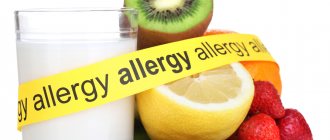Authorized Products
If a food allergy is determined, a special diet will be an important element of treatment. It is based on products that are considered hypoallergenic, that is, not causing negative reactions from the immune system.
White poultry meat (turkey and chicken), vegetable oil, rice, buckwheat, oatmeal, fermented milk products, green vegetables, potatoes, unsalted cheese, apples and green pears, unleavened bread (without yeast), crackers from white bread without additives, dried fruits, black and green tea.
The set of permitted food products is individual, so the exact diet for a particular person should be drawn up together with the attending physician.
Try to diversify your diet by consuming the same product no more than once every 3-4 days. This is necessary to ensure that specific food proteins do not accumulate in the body and cause the development of a new allergy attack.
Quitting the diet
To avoid causing serious harm to your body, adhere to the following rules:
- exit the diet slowly, it will take 2-3 days;
- do not consume large quantities of sweets, as well as prohibited foods;
- watch your drinking regime, consume enough liquid;
- minimize contact with unfamiliar dishes;
- Avoid overeating.
Exiting the diet should be smooth; for 2-3 days, stick to the diet described above, gradually adding new foods. Don't eat too much; moderate food intake will avoid increasing the load on the gastrointestinal tract and liver.
What foods to exclude from the menu
If you are on a hypoallergenic diet, you should avoid the following foods:
- fish;
- citrus;
- nuts;
- coffee;
- chocolate;
- smoked meats;
- hard cheese;
- eggplant;
- eggs;
- tomatoes;
- mushrooms;
- honey;
- canned and pickled vegetables and fruits;
- mayonnaise and ketchup;
- alcohol;
- a pineapple;
- melon;
- all orange or red berries or fruits;
- spicy vegetables (radish, radish, horseradish);
- full-fat milk and dairy products;
- confectionery, fresh bread and pastries.
If you notice unwanted reactions (rashes, swelling, runny nose) after eating any other products (not on this list), they should also be completely excluded.
Sample menu for a general hypoallergenic diet
To create an antihistamine diet menu for the week, be sure to take into account not only increased sensitivity to certain foods, but also the likelihood of “cross-allergy”. Thus, often people suffering from hay fever during the flowering period of birch cannot tolerate apples, plums, and hazelnuts (hazelnuts). And increased sensitivity to coffee almost always means an active reaction of the body to legumes.
If you have a severe reaction to cow's milk, it is better to avoid veal and beef, as well as soy and products containing stomach enzymes from cattle.
Intolerance to carrots may also indicate hypersensitivity to parsley, celery, vitamin A and carotene.
If you are allergic to fish, it is advisable to exclude fish and seafood, and also avoid contact with aquarium fish food, which is made from daphnia (water flea).
The proposed hypoallergenic diet menu option is indicative and can be changed or supplemented on the recommendation of an allergist or nutritionist.
First day
Breakfast: millet porridge with prunes, green tea.
Lunch: creamy cauliflower soup, steamed turkey meatballs, apple jelly.
Dinner: rice porridge with boiled beef or lean pork, low-fat kefir.
Second day
Breakfast: low-fat yogurt, 2 crackers of wheat bread with avocado, tea.
Lunch: stewed cabbage with rice, dried fruit compote.
Dinner: beef goulash, boiled potatoes, pear.
The third day
Breakfast: pasta with stewed vegetables, tea.
Lunch: porridge, apple, compote.
Dinner: boiled fish, stewed zucchini, jelly.
Fourth day
Breakfast: fruit salad, yogurt with biscuits.
Lunch: lean borscht, steamed cutlets, juice.
Dinner: vegetables stewed with pork, tea.
Fifth day
Breakfast: oatmeal with fruit, tea.
Lunch: vegetable soup with beef, kefir, fruit.
Dinner: porridge with vegetables, jelly.
Sixth day
Breakfast: turkey sandwich, yogurt, fruit.
Lunch: meat soup, banana, tea.
Dinner: pasta, cabbage salad, compote.
Seventh day
Breakfast: vegetable casserole with tea.
Lunch: vegetable stew, steamed meatballs, yogurt.
Dinner: porridge with cutlet, fruit jelly.
First aid for food allergies
They independently provide first aid for allergies to food additives, if the person’s life and health are not in danger.
What symptoms indicate a direct threat:
- breathing problems;
- swelling of the neck, tongue;
- altered speech;
- confusion.
All of the above is a reason to call an ambulance . If an allergic reaction appears for the first time, even without symptoms that threaten health, it is necessary to get medical help as soon as possible, especially if we are talking about a child.
If symptoms are not expressed, it is permissible to take the first measures yourself. The following categories of drugs are used for this:
- Sorbents. They allow you to bind and remove harmful substances from the gastrointestinal tract. Such drugs accelerate the elimination (removal) of allergens, alleviate the condition and speed up recovery.
An effective product from this group is Fitomucil Sorbent Forte, which contains the shell of psyllium seeds, as well as the prebiotic inulin and a complex of live probiotic bacteria. Psyllium seed husk is a natural soluble fiber that absorbs water and allergens into a mucilaginous gel. The drug does not irritate the intestinal walls, gently stops diarrhea, promoting thickening of stool.
- Antihistamines. Today there is a wide range of new generation medications that do not have side effects such as drowsiness and are well tolerated. It is better to choose medications from those you have already taken before, or consult a doctor.
For skin manifestations, it is possible to use local agents with antihistamine and soothing, antipruritic effects. Severe allergies, manifested by severe redness and itching of the skin, will most likely require the use of local hormonal ointments and creams.
But remember that they are prescription drugs and cannot be used for longer than the time prescribed by the doctor - usually about 7-10 days for mild to moderate cases. Hormonal drugs for oral administration or injection also require a prescription from a specialist who will develop a suitable regimen for use.
Developed vomiting and diarrhea require action. Taking sorbents will help in the second case, and in case of uncontrollable vomiting, you should seek emergency help. If vomiting and diarrhea occur sporadically, several times a day, it is necessary to replenish fluid loss with the help of special rehydration solutions - pharmacy or self-prepared.
It is necessary to drink enough fluids to prevent dehydration and the occurrence of associated disorders. Kozyarin suggests using herbal tea, decoctions of plants: “chamomile, St. John’s wort, calendula, calamus, valerian” (Kozyarin N.P., 2009, p. 66).
Diet for atopic dermatitis
The chronic form of allergies - atopic dermatitis - requires maximum attention to nutrition. All recipes should be as simple as possible, and the quality of the products should not raise the slightest doubt.
For atopic dermatitis, wheat, bananas, honey and sugar, red and orange vegetables, fruits or berries, milk and dairy products, eggs, fatty meats and fish, chocolate, herbs and spices, coffee, vinegar, nuts, sweets should be excluded from the menu. , spicy dishes.
Prepare soups from soaked vegetables and cereals, steamed cutlets from turkey or lean meat, casseroles, vegetable purees with the addition of vegetable oil, porridge from permitted cereals, dried fruit compotes.
Diet recipes
Corn porridge in a slow cooker (steamer)
Place washed corn grits (200 grams) into a cup for steaming rice and fill with water in a ratio of 1 to 4 (4 cups of water for each cup of grits). Set the steamer timer for 30 minutes.
At the end of the cycle, add a little salt to the porridge, add a couple of tablespoons of vegetable oil and mix well. If necessary, you can add a little hot water. Turn on the steamer for another 5 minutes. Leave the steamer with the porridge closed for 10-15 minutes, so that it steams well. When serving, the porridge can be supplemented with stewed vegetables, meatballs or natural yogurt.
If you want to cook a large portion of porridge at once, keep in mind that it will take more time to warm up and cook.
Dinner in a slow cooker
Soak peeled, washed and cut into pieces potatoes and cauliflower with water for an hour. Divide the soaked vegetables: place the potatoes in the multicooker bowl, and the cauliflower in the overhead steamer (upper compartment). Cover the cabbage with slices of turkey fillet (cut the meat into medium-sized pieces, you can beat it lightly). Sprinkle with a little sea salt and cook for an hour in the "Steam" mode.
It is better to serve the finished dish with natural yogurt or low-fat sour cream.
Features of the menu for nursing mothers
During lactation, it is important to monitor the nutrition of a nursing mother, since food directly affects the quality of breast milk and its composition. So, when eating chocolate, citrus fruits, too fatty foods or products containing dyes, flavors or other synthetic additives (stabilizers, emulsifiers), the baby’s fragile immune system may react too violently: rashes on the cheeks, colic, bloating, constipation or diarrhea.
Mothers who themselves suffer from allergies should pay special attention to nutrition. It has been proven that the tendency to food sensitivities is inherited, which means that the likelihood of allergies developing in children, one (or both) of whose parents suffer from allergies, is much higher.
In this case, the basis of a nursing mother’s diet should be dairy-free cereals, vegetarian soups made from permitted vegetables and cereals, fruits and berries of dim colors, and dried fruits.
Diarrhea due to food allergies
Researcher Kozyarin points out the high probability of diarrhea with food allergies: “If a person is not treated, then he may experience inflammation of the stomach and small intestine with abdominal pain and constant stool upset” (Kozyarin N.P., 2009, p. 66).
Allergies disrupt the frequency of bowel movements, with diarrhea observed for several days, which is often followed by constipation. This is not harmless, especially for people who already have intestinal problems.
Damage to the walls of the intestines and stomach leads to disruption of the processes of digestion and absorption of nutrients. If measures are not taken in a timely manner, thickening of the walls, a decrease in the intestinal lumen, and serious consequences in the form of persistent stool disorders and abdominal pain are possible.
An allergic reaction disrupts the balance of intestinal microflora . The mechanisms of influence of allergic processes on digestion are so diverse that independent gastroenterological diseases often develop, such as gastritis, peptic ulcers, and enzymatic deficiency in children. At the same time, treatment of these pathologies by a specialized specialist without adjusting the diet and taking measures to eliminate allergies is not always successful.
Diarrhea due to allergies can independently lead to complications - proctological pathologies, water-salt imbalance, and dehydration. Therefore, it is important to resort to symptomatic therapy before basic measures take effect.
Reintroduction of products to identify hypersensitivity
Best materials of the month
- Coronaviruses: SARS-CoV-2 (COVID-19)
- Antibiotics for the prevention and treatment of COVID-19: how effective are they?
- The most common "office" diseases
- Does vodka kill coronavirus?
- How to stay alive on our roads?
A long-term hypoallergenic diet can cause the development of hypovitaminosis or a lack of minerals, so most often doctors prescribe additional vitamin-mineral complexes.
After a period of strict diet, when all manifestations of allergies (rash, swelling, runny nose) have completely disappeared, you should gradually begin to introduce new foods.
This way, you can accurately identify the foods that cause a particular reaction. In addition, it is not uncommon for a rash or swelling to occur after exceeding a certain dose of the product. For example, one toast made from wheat bread does not cause discomfort, but after two or three pieces, discomfort in the stomach, itching or rashes on the skin appear. This means that to prevent allergic reactions you will only need to not exceed portions of foods that are safe for you.
Remember that products must be introduced one at a time, starting with a portion of 10 grams on the first day, gradually increasing it to 150 grams over the course of a week. If after a week of continuous use there is no repeated reaction, the product can be considered permitted and used in the daily diet (in reasonable quantities).
A new product can be introduced no earlier than 2 weeks after the previous one has been completely introduced.
Be sure to keep a food diary, where you write down not only a detailed list of all the foods you eat during the day, but also your well-being, the presence/absence of allergic reactions. This will help you more accurately track reactions to certain food combinations.
Causes of food allergies
There are several mechanisms for the development of allergies. But a significant proportion of cases are associated with type 1 hypersensitivity. It is explained by the release of immunoglobulin IgE and the activation of basophils. This reaction occurs in response to the entry into the digestive system of protein compounds recognized by immune cells.
Some predisposing factors are unique to children, others are also found in adults. Among the most common reasons are the following:
- Features of allergens in food. The reaction is most often provoked by antigens with high immunogenicity. They easily overcome the aggressive environment of the stomach. They are found in large quantities in whole milk, fish, eggs, cereals, strawberries, citrus fruits, and nuts.
- Hereditary predisposition. Food allergies are associated with hereditary characteristics of the body. They manifest themselves by increased reactivity, disruptions in the functioning of the immune system, as well as other mechanisms.
- Age-related features of the development of the digestive system. Children have high permeability of the stomach walls, and the acidity of gastric juice is lower than in adults. The composition of the microflora is also different. All this creates favorable conditions for the allergen to come into contact with immune cells.
The condition may be associated with the amount of food eaten and the characteristics of culinary processing. There are cases of so-called cross-allergy to pollen and household dust: some food products with similar compounds in their composition trigger an allergic reaction.
According to many researchers, the formation of allergies is facilitated by dietary violations during pregnancy, as well as early transfer of the child to artificial feeding. Gastrointestinal diseases, especially diseases of the liver, gallbladder, and biliary tract, also trigger and contribute to the exacerbation of allergies.









